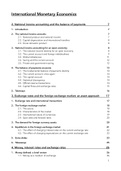Resume
Summary Chapters 2-8 & 10 of International Monetary Economics
- Établissement
- Vrije Universiteit Brussel (VUB)
This is a summary of the lectures for the course International Monetary Economics. It covers chapters 2-8 and 10 and follows the structure of the book. It is somewhat extensive and contains detailed explanations of the models and scenarios seen in the course.
[Montrer plus]













